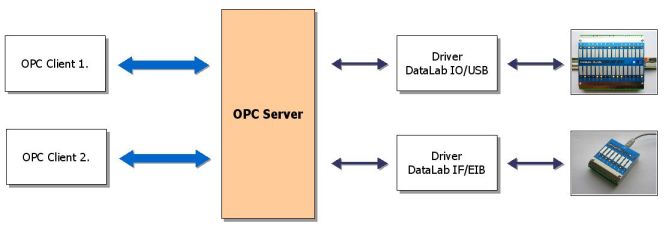|
The OPC Data Access became the widest spread standard for data
exchange between industrial automation devices and the visualization
and control applications. The OPC is based on Microsoft COM
technology, which allows relatively good efficiency low overhead on
the one side and good support within the operating system itself on
the other side (number of components of Windows uses COM technology,
too).
The OPS client connected to the server can choose from a number of
ways to exchange data (synchronous, asynchronous, call-back
notification), it can require data directly from the device or from
the server cache etc. All these possibilities (and also the usage of
relatively complex COM technology) makes full implementation of OPC
server rather difficult. Development of OPC server is almost
impossible for a small company without a team of experienced
programmers and also big, rich and famous companies have significant
problems with development of the server fully complying to the
standard (they are usually satisfied when the server works well with
their clients and they often omit other ways of data exchange). Number
of companies rely on various “OPC Server Toolkits” made by
third parties. This approach also often fails — although it enables implementation of the OPC server to
less-experienced programmers, an absence of in-depth understanding of
the standard prohibits the programmers to correctly implement the
server either way. If a problem occurs, programmers usually cannot
localize it, they do not know which parts of their code is called in
various contexts etc.
Moravian Instruments has wide experience in implementation of OPC
clients and servers and the development team carefully implemented the
OPC interface. On the other side the OPC Server uses the
Control Web driver interface. This interface is very
efficient (it uses direct procedural API implemented in DLLs) so there
is no other software layer between the driver and its user. At the
same time this API is universal enough to cover all devices — communication can be synchronous or asynchronous (for
devices with delayed response caused e.g. by communication delays),
the driver always knows which data elements should be transferred in
the particular time so it can optimize creation of protocol packets
etc.
The Control Web driver interface is open and well
documented. There are not only drivers implemented by Moravian
Instruments, but also number of drivers implemented by third parties.
These companies automatically gain the possibility to supply the OPC
Server for devices, for which they already implemented the
Control Web driver. If it is necessary to implement a
new OPC server for some device, it is much easier and often more
efficient to implement driver for Control Web than
starting with the OPC server from the ground up.

Communication between OPC client and the device through the
OPC server and Control Web driver Although the OPC server for Control Web drivers is
a licensed product, number of drivers are available for free.
Control Web driver is supplied with every
DataLab IO/USB or DataLab IF/EIB device (and also drivers in the form of
Active X component). If it is necessary to communicate with these
devices through OPC interface, the OPC Server is available for all
clients.
| 